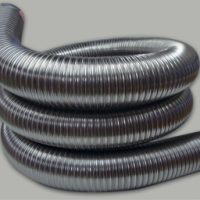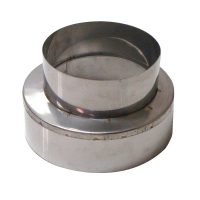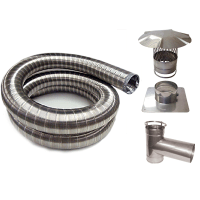The stack effect is when an unused flue has smoke coming out of it. Most cases are when a home has 2 fireplaces, and the unused fireplace starts smoking. This is called the stack effect.
On chimneys with multiple flues, the flue tiles should be staggered in height to help prevent one flue from sucking smoke downward from the adjacent one. A chimney should be built so that its flues can be as straight as possible, bends and offsets increase resistance and slow the exit of the smoke which can cause drafting problems.
It’s preferable to have the chimney built closer to the peak of the roof than on the lower side to reduce problems associated with a stack effect within the house, where there is a great difference in pressure between the air in the house and outdoor air. Air within the house leaves it, often from the upper sections such as the roof or upstairs windows. Entry air must be provided to replace the air that is exiting. When the chimney is on the lower side of the roof, replacement air may be drawn down the chimney. This can cause a competition between cold air being sucked down the chimney while the smoke is simultaneously trying to rise from it. A common problem is a chimney located in a one story room of a 2 story house which commonly suffers from negative pressure problems.
In our compulsive obsession to design energy-efficient “air tight” homes, we often don’t consider there must be means for outdoor air to enter the house to operate the devices we use in them. Chimneys must pull air from somewhere to provide combustion air for the fire AND allow an updraft so smoke and fumes can exit, so air must be supplied at an equivalent rate to replace the air leaving the chimney. Extremely airtight homes can prevent chimneys from operating properly, especially where other air-moving devices are being used such as furnaces, bathroom or kitchen vents, attic fans, clothes dryers, etc. Again, replacement air for these devices AND for the chimney may be entering through the chimney. It is possible to have cold air dropping down one side of flue while warm smoke or fumes are also trying to exit at the same time. Try cracking open the closest window to the fireplace to provide extra air for the fireplace AND make sure no other air-moving devices are being used in your home at the same time.
The chimney needs to be at least 3′ higher than the roof where it penetrates AND 2′ taller than anything within 10′ away.
If your chimney once worked well and now doesn’t, consider whether you may have made alterations that affect its ability to draft, such as weatherstripping, replacement windows, new siding, extra insulation, room additions, or new appliances. High efficiency clothes dryers that dry clothes more quickly can use drastically more air to operate.
Chimney and fireplace professionals may be able to suggest alterations to improve or cure your smoking or malfunctioning fireplace in SOME situations. If your new stove or fireplace is not working properly, have it checked by a pro for advice. But remember, using the best principles of design for a fireplace or stove installation may not be overcome by the design of the house and the way that air enters and leaves it. Simply put, we in the fireplace industry cannot solve smoking or draft problems in every situation.
One thing that helps many times is and outside air kit. This is basically a connection from the furnace, wood stove, fireplace or any other appliance to the outside. This is designed so it takes air from the outside and burns that air instead of taking air from the inside of the home. This will reduce drafts coming into the home and may make the appliance run better if it was “starving” for air.






